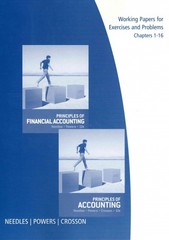Question
Question 1. Costs associated with holding inventories and the resulting opportunity cost of the investment tied up in inventory fall into which of the following
Question 1. Costs associated with holding inventories and the resulting opportunity cost of the investment tied up in inventory fall into which of the following categories?
A. stockin costs
B.ordering costs
C. stockout costs
D.quality costs
E. carrying costs
Question 2. Negotiated transfer prices are always transacted at the top management levels.
True/False
Question 3. The net initial investment for a new mainframe computer is $1,000,000. Annual cash flows are expected to be, $200,000 year one- $300,000 year two-$400,000 year three- $300,000 year fourThe required rate of return is 12%. What is the payback period?
A.3.80 years
B.2.43 years
C.3.45 years
D.2.33 years
E.None of these.
Question 4: Which of the following statements is FALSE?
A.
Decentralization can increase motivation by allowing managers to exercise greater individual initiative.
B.
A decentralized structure forces top management to lose some control over the organization.
C.
The extent to which decisions are pushed downward, and the types of decisions that are pushed down, provide a measure of the level of centralization/decentralization in an organization.
D.
Decentralization slows responsiveness to local needs for decision making.
E.
A centralized structure does not empower employees to handle customer complaints directly.
Question 5: In selecting capital projects, organizations choose
A.
the alternative that has the highest revenues.
B.
the alternative that has the longest time horizon, but also exceeds the RRR.
C.
the alternative that matches the RRR.
D.
the alternative that provides benefits that exceed predicted costs by the greatest amount.
E.
the alternative that has revenues that exceed its costs.
Question 6 : Hoffman Company purchased a new machine for $138,000. The machine has a useful life of 3 years. Net cash flows will be $50,000 per year, end of year payments.Additional information:Present value of annuity $1 in Arrears
| Periods | 2% | 4% | 6% | 8% | 10% |
| 1 | 0.980 | 0.962 | 0.943 | 0.926 | 0.909 |
| 2 | 1.942 | 1.886 | 1.833 | 1.783 | 1.736 |
| 3 | 2.884 | 2.775 | 2.673 | 2.577 | 2.487 |
What is the internal rate of return?
A. More than 2 percent but less than 4 perecent
B. 3.75 percent
C.4.80 percent
D. 2.36 percent
E. None of these.
Question 7: Return on investment (ROI) is also known as
A. timeadjusted rate of return.
B. net present value.
C. accrual accounting rate of return.
D. payback.
E. internal rate of return.
Question 8:
All of the following statements about EOQ model are true EXCEPT
A.In some companies, average annual carrying costs represnt significant percentage of purchasing costs.
B.Economice ordering quantity model is used to calculate the maximum amount of inventory to order.
C.Economice ordering quantity model eliminates purchasing costs.
D.Increase in the carrying costs and decrease in the ordering costs result in smaller EOQ amount.
E. None of these.
Step by Step Solution
There are 3 Steps involved in it
Step: 1

Get Instant Access to Expert-Tailored Solutions
See step-by-step solutions with expert insights and AI powered tools for academic success
Step: 2

Step: 3

Ace Your Homework with AI
Get the answers you need in no time with our AI-driven, step-by-step assistance
Get Started


